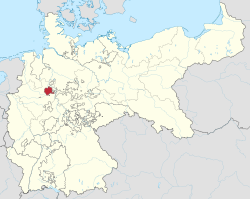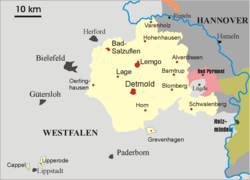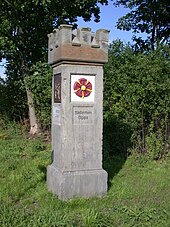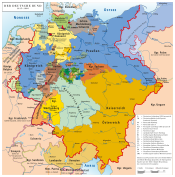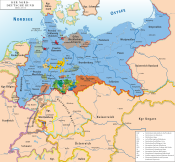
Westphalia is a region of northwestern Germany and one of the three historic parts of the state of North Rhine-Westphalia. It has an area of 20,210 square kilometres (7,800 sq mi) and 7.9 million inhabitants.
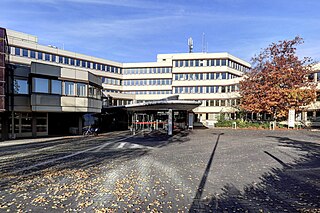
Lippe is a Kreis (district) in the east of North Rhine-Westphalia, Germany. Neighboring districts are Herford, Minden-Lübbecke, Höxter, Paderborn, Gütersloh, and district-free Bielefeld, which forms the region Ostwestfalen-Lippe.

The County of Waldeck was a state of the Holy Roman Empire and its successors from the late 12th century until 1929. In 1349 the county gained Imperial immediacy and in 1712 was raised to the rank of principality. After the dissolution of the Holy Roman Empire in 1806 it was a constituent state of its successors: the Confederation of the Rhine, the German Confederation, the North German Confederation, and the German Empire. After the abolition of the monarchy in 1918, the renamed Free State of Waldeck-Pyrmont became a component of the Weimar Republic until divided between Hannover and other Prussian provinces in 1929. It comprised territories in present-day Hesse and Lower Saxony (Germany).

Detmold is a city in North Rhine-Westphalia, Germany, with a population of 73,969. It was the capital of the small Principality of Lippe from 1468 until 1918 and then of the Free State of Lippe until 1947. Today it is the administrative center of the district of Lippe and of the Regierungsbezirk Detmold. The Church of Lippe has its central administration located in Detmold. The Reformed Redeemer Church is the preaching venue of the state superintendent of the Lippe church.
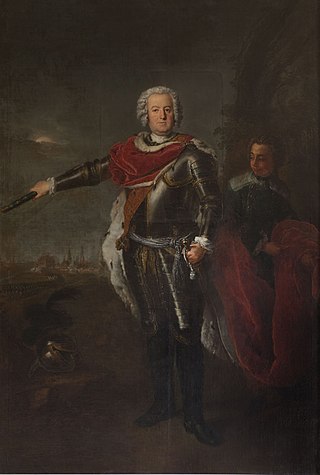
Leopold II Maximilian, Prince of Anhalt-Dessau, was a German prince of the House of Ascania and ruler of the principality of Anhalt-Dessau from 1747 to 1751; he also was a Prussian general.

Blomberg is a town in the Lippe district of North Rhine-Westphalia, Germany, with c. 15,100 inhabitants (2019).

Lage is a town in the Lippe district of North Rhine-Westphalia, Germany, approximatively 8 km northwest of the administrative centre Detmold. It has 35,099 inhabitants (2016). The coat of arms of Lage depicts a farmer's plough. The city is not far from the Teutoburg Forest. Due to its convenient location Lage developed into a traffic hub in the former Principality of Lippe, today's district of Lippe.
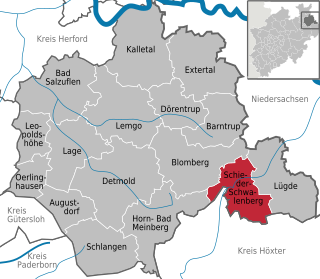
Schieder-Schwalenberg is a town in the Lippe district, in North Rhine-Westphalia, Germany. It is situated approximately 20 km (12 mi) east of Detmold.

Leopold IV, Prince of Lippe was the final sovereign of the Principality of Lippe in northwestern Germany from 1905 until his abdication in 1918. Prior to succeeding to the throne, he had been governing the state since 1904 as regent. He was the first and only ruler of Lippe of the Lippe-Biesterfeld branch.

Alexander, Prince of Lippe was the penultimate sovereign of the Principality of Lippe. Succeeding to the throne in 1895, Alexander had his power exercised by a regent throughout his reign on account of his mental illness.

Leopold III of Lippe was the sovereign of the Principality of Lippe reigning from 1851 until his death.

Ernst, Count of Lippe-Biesterfeld was the head of the Lippe-Biesterfeld line of the House of Lippe. From 1897 until his death he was the regent of the Principality of Lippe.

Stephan, Prince of Lippe was born on 24 May 1959 in Detmold, Germany. He is the son of Armin, Prince of Lippe and Traute Becker, and the current head of the House of Lippe since 2015. His traditional titles include Prince of Lippe, Lord and Count of Biesterfeld, Count of Schwalenberg and Sternberg, Hereditary Burgrave of Utrecht, etc.

The House of Lippe is the former reigning house of a number of small German states, two of which existed until the German Revolution of 1918–19, the Principality of Lippe and the Principality of Schaumburg-Lippe.

The House of Lippe-Biesterfeld was a comital cadet line of the House of Lippe.

Princess Anna of Ysenburg und Büdingen was the youngest child of Bruno, Prince of Ysenburg and Büdingen and his second wife, Countess Bertha of Castell-Rüdenhausen. Through her second marriage to Leopold IV, Prince of Lippe, Anna was the titular Princess consort of Lippe.

The House of Lippe-Weissenfeld is one of the junior branches of the House of Lippe, a dynasty ruling the Principality of Lippe until the German Revolution of 1918–19.

The County of Lippe or Lippe-Detmold was an Imperial Estate of the Holy Roman Empire. It had its origins in a small lordship on the Lippe river, first attested in 1123, and lands leased from the Bishopric of Paderborn from 1173. In the late twelfth and early thirteenth centuries, the lords of Lippe founded several cities, the earliest city-foundations in Westphalia. The territory achieved Imperial immediacy in 1413 at the latest and was part of the Lower Rhenish–Westphalian Circle from 1512. In 1528 or 1529, it was promoted to the status of Imperial County and became part of the College of Lower Rhenish-Westphalian Imperial Counts in the Imperial Diet. Lippe was a centre of conflict during the Reformation as Count Simon V attempted to prevent Protestantism from spreading within his territory by force. Lutheranism was adopted in 1538, two years after his death. Simon VI converted to Calvinism in 1605, leading to a prolonged conflict with Lemgo, which eventually remained Lutheran. On his death in 1613, Simon VI left substantial lands and rights to his younger sons, who formed junior lines: Lippe-Brake and Lippe-Alverissen, while the main line became known as Lippe-Detmold. The Counts' efforts to centralise the state and expand its military and bureaucracy in the eighteenth century were stymied by the power of the junior lines and the nobility. In 1789 it became the Principality of Lippe.

Pauline Christine Wilhelmine of Anhalt-Bernburg was a princess consort of Lippe, married in 1796 to Leopold I, Prince of Lippe. She served as the regent of Lippe during the minority of her son from 1802 to 1820. She is regarded as one of the most important rulers of Lippe. On 1 January 1809, she abolished serfdom by princely decree. She managed to keep the principality independent during the Napoleonic Wars. She wrote a constitution, in which the power of the estates was reduced. In the collective historical consciousness of the Lippe population, however, she is best remembered for her social goals. Influenced by French reformist writings, she founded the first day care center in Germany, a labor school for neglected children, a voluntary work camp for adult charity recipients and a health care institution with first aid center.
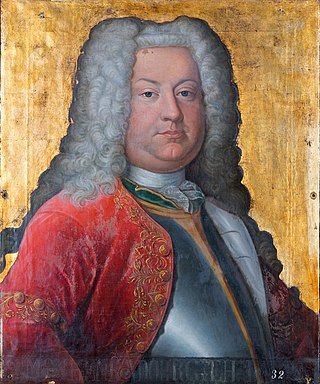
Simon Henry Adolph, Count of Lippe-Detmold was a ruler of the county of Lippe.
